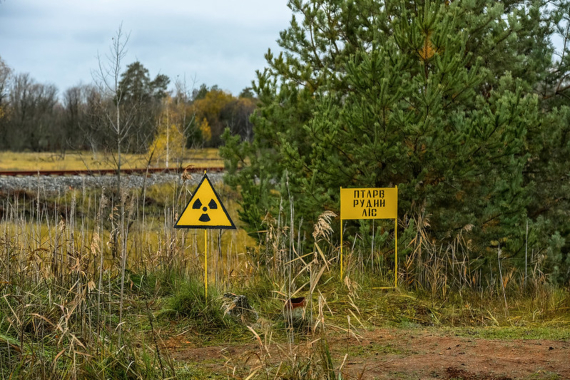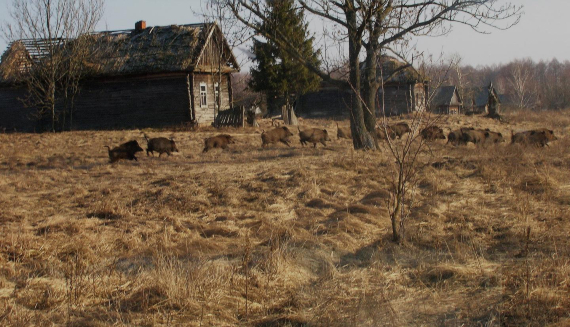Thirty-five years ago, on 26 April 1986, the failure of a safety test designed to assess the emergency protocol in the event of a power failure triggered the explosion of reactor number 4 at the Chernobyl nuclear power plant in the Soviet Union. The worst nuclear accident in history immediately killed 10 km2 of pine trees around the plant, whose needles turned ginger-brown, burned by radiation; today this area is known as the Red Forest. After 116,000 people were evacuated from the affected region, it was believed that it would be a lifeless desert for decades. The so-called Chernobyl Exclusion Zone (CEZ), covering some 2,600 km2 in Ukraine and 2,160 km2 in Belarus, was dubbed the “dead zone”.
And yet, years later, reports began to emerge of an unusual apparent increase in wildlife in the CEZ, albeit with contradictory data. A 2015 census showed that the populations of large mammals, such as deer, roe deer, wild boar and elk, were similar to those in nearby nature reserves, while wolves were seven times more abundant. But these observations raise a logical question: is the fauna actually thriving in Chernobyl, or are the animals taking refuge there fleeing from inhabited environments, even at the cost of succumbing to radiation?
Repopulation and absence of human pressure
Jim Smith, a radioecologist and Professor of Environmental Science at the University of Portsmouth (UK), co-author of the book Chernobyl: Catastrophe and Consequences (Springer, 2005) and the director of that 2015 study, summarised to OpenMind: “I think it is very clear that there is a thriving wildlife population.” According to Smith, “there are around 100 species which are in the Red Data Book of rare species of Ukraine.” He and many other researchers have no doubt about the reason for this repopulation: the absence of human pressure. Wildlife abounds where it can take refuge from us.

Similarly, Smith does not believe that animals are fleeing from humans near Chernobyl only to find radiation levels there that are lethal to them or harmful to the reproductive health of the species. “It is important to remember that the CEZ varies hugely in levels of contamination. There are some hot spots such as the Red Forest.” In these places, says the researcher, a relatively subtle impact of radiation is observed. “For example, we have seen some effects on the development of reproductive organs in fish in the most contaminated lakes, including the Cooling Pond, the reservoir which held cooling water for the reactors.”
But Smith stresses that these hot spots only represent a small part of the CEZ. “In most of the zone, radiation dose rates are relatively high, but within the range of natural background radiation dose rates we see worldwide. We don’t see significant individual or population effects.” Smith cites other studies with small mammals in the Red Forest that also do not suggest a large impact of radiation on the health of populations.
New species in the area
It is not only mammals that seem to thrive near Chernobyl. Germán Orizaola, an evolutionary ecologist from the University of Oviedo (Spain), has been studying amphibian and other animal populations in the CEZ for four years. “The general biodiversity of both amphibians and other animal groups has not been affected by the accident. The same species that lived in the zone in 1986 do so now, with the addition of some new ones such as the brown bear (which arrived naturally in the CEZ), the European bison (which also arrived naturally from the population introduced in Belarus), and the Przewalski horses (introduced into the CEZ in 1998),” he tells OpenMind. According to Orizaola, while estimates of population sizes may vary with the sampling methods employed by different groups of researchers, in general a large abundance of amphibians is found throughout the CEZ, including the most contaminated areas.

The ecologist has, however, observed certain effects associated with radiation which he will describe in a forthcoming study, such as a darker colouration in the frogs of the species Hyla orientalis, which are normally bright green and which in the CEZ have become completely black. “We understand this difference as an adaptive response, in which the presence of more melanin in the skin of these frogs would be beneficial to them in some way for living in environments with radioactive contamination,” he says. However, Orizaola stresses that these effects do not affect the health of populations: “Abnormal situations can be detected in some individuals, but it seems quite clear that they do not negatively impact populations.” The researcher concludes that “the virtual absence of human activity in the zone seems to be much more beneficial for the fauna than the effect of the radioactive contamination still existing in some places.“
Part of a more general phenomenon
However, not all experts agree with these positive assessments. As Anders Pape Møller, an evolutionary ecologist at the University of Paris-Sud (France) told OpenMind, the dissemination of news about the Chernobyl fauna may have given an exaggerated impression. “Last year there were more than 50,000 tourists in Chernobyl, but many tourists are angry because they don’t see any big mammals,” he says. The researcher himself claims to have seen only one fox and two roe deer in a week. “And that was it. It’s not really a wildlife haven.”
Møller says that large mammals are increasing their presence across Europe, and that what was observed at Chernobyl would simply be part of a more general phenomenon. The researcher is preparing a study that shows how a higher level of ambient radiation corresponds to a lower number of mammals. Moreover, Møller says that various animals are suffering significant damage: “The higher the level of radiation, the larger the number of anomalies. In the most contaminated areas there are more abnormal limbs, spots in the pelage of mammals and the plumage of birds with abnormal colour.“
The case of Fukushima
The case of Chernobyl has been joined in more recent times by that of Fukushima, Japan, where on 11 March 2011, a tsunami caused the second largest nuclear accident in history. University of Georgia (USA) ecologist James Beasley, who has also researched the area around Chernobyl, published a study last January using camera traps in the evacuated area around the Japanese plant, where there were abundant animal populations suffering no apparent effects of radiation.
“While it is unknown how these populations will fare in the future, in both Chernobyl and Fukushima several species exhibited a rapid increase in population size in the first several years after the accident, and in Chernobyl populations of these species remain abundant over 30 years later, several generations,” Beasley told OpenMind. The ecologist adds that “there is also abundant evidence that many large mammal species are successfully reproducing throughout the evacuated areas,” and therefore the viability of these populations is probably not simply maintained by animals fleeing from nearby areas due to human pressure, although he points out that this has yet to be confirmed by further studies.
It will be these future investigations that will make it possible to settle the debates that are still pending on these new and unusual fauna strongholds created by the disaster. But in any case, as Smith points out, even from these disasters we must learn environmental lessons: “The CEZ now represents one of the largest conservation areas in Europe, and it is important that we value and protect this accidental nature reserve.“
Comments on this publication